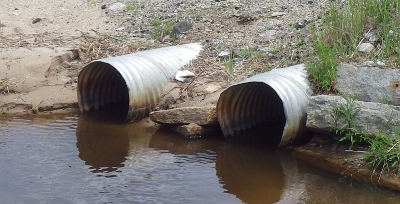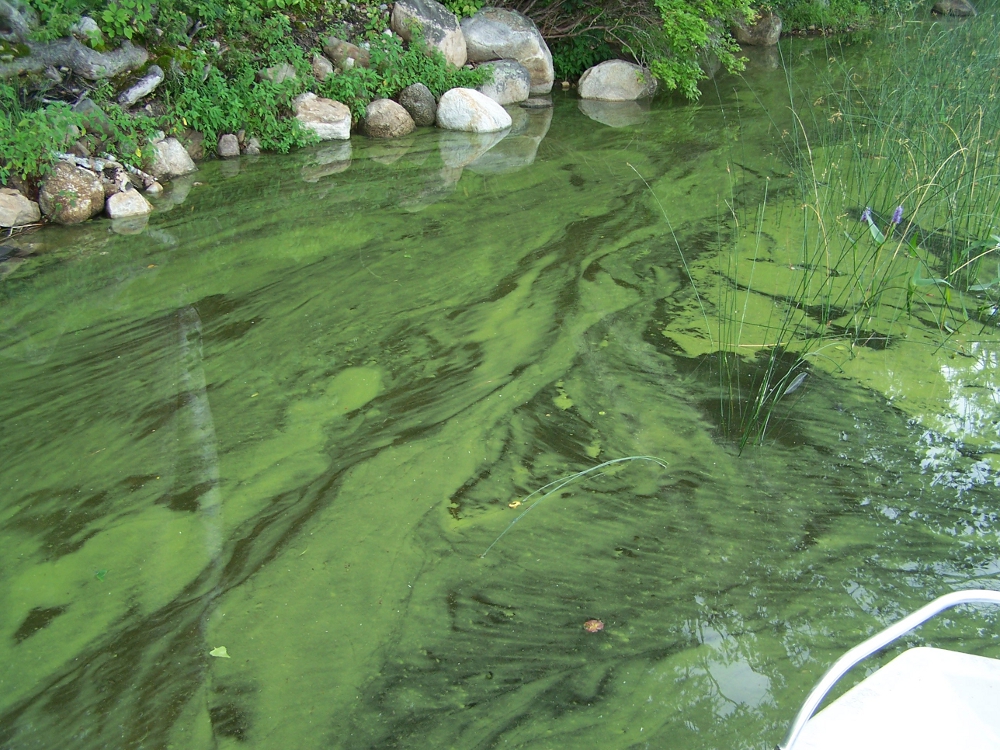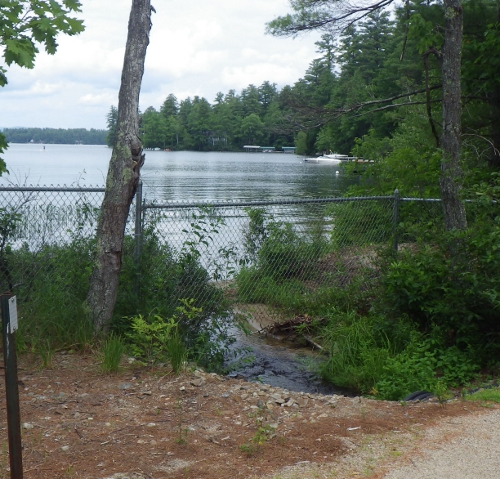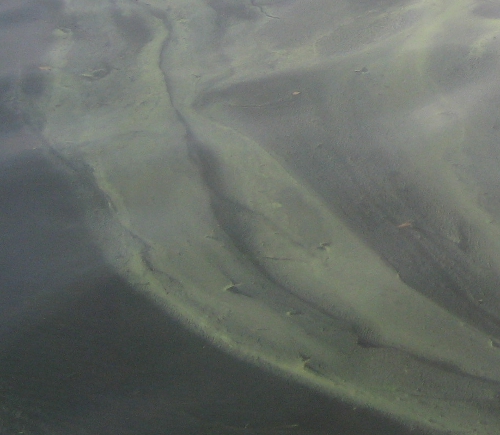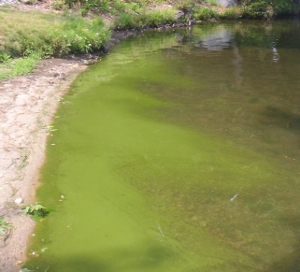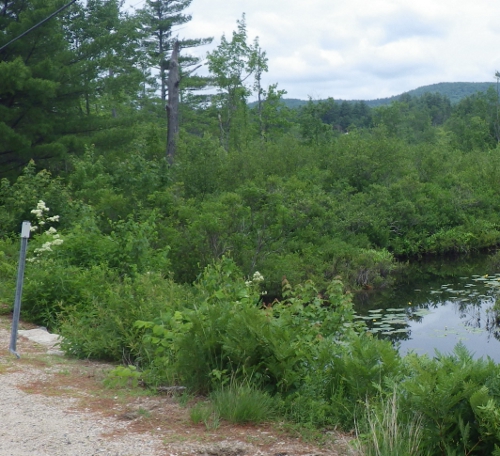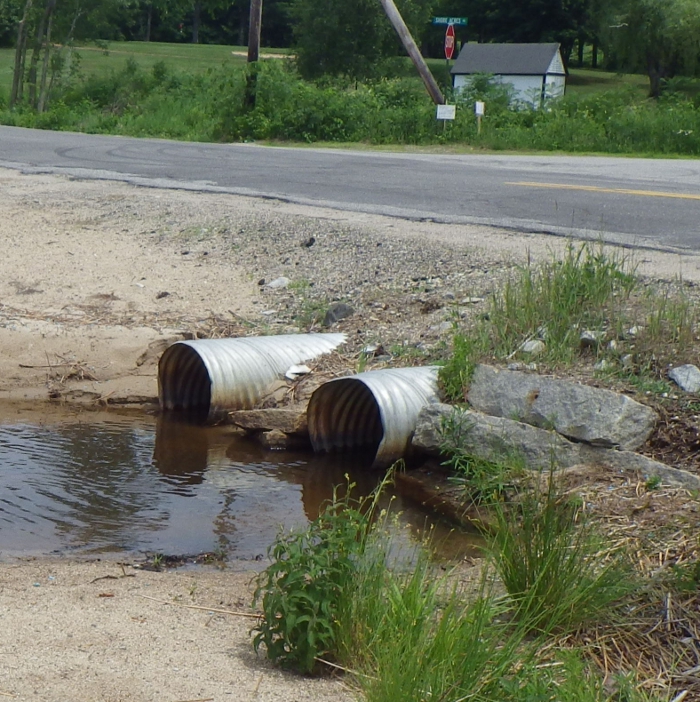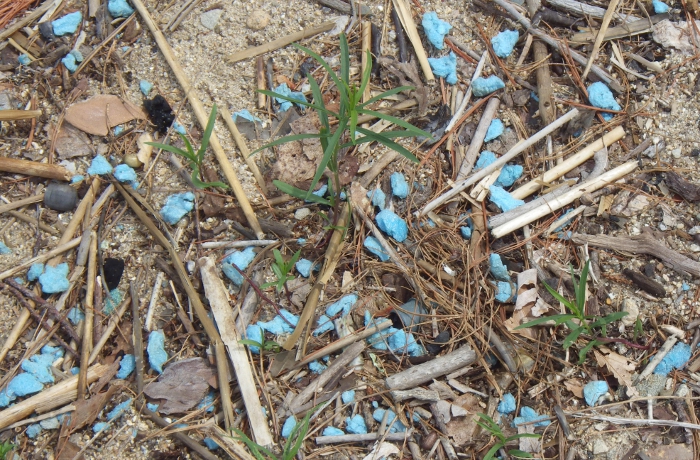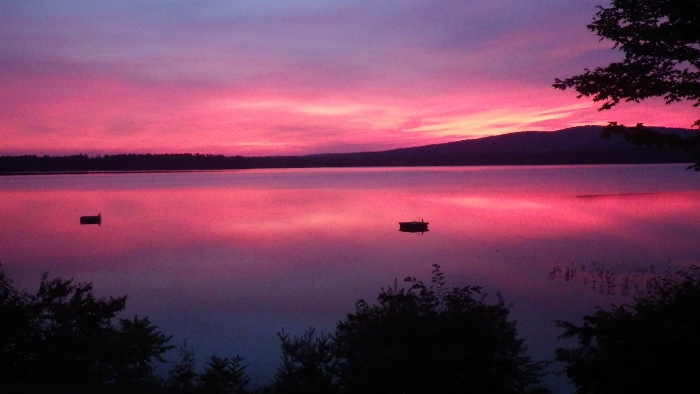Water Quality Monitoring of Province Lake
Effingham & Wakefield, New Hampshire, and Parsonsfield, Maine
2013 Report - Published Online on July 16, 2014
2013 was the 23rd consecutive year of water quality monitoring conducted at Province Lake as part of the New Hampshire Volunteer Lake Assessment Program (VLAP). Sampling was conducted more times last season than any other year since sampling began in 1991. The deep spot was sampled 4 times. The standard inlets and lake outlet were sampled 6-8 times, while several other places were sampled 2-4 times. The extra sampling was conducted as part of the Province Lake Watershed Management Plan (PL WMP) currently being prepared. Results from the extra sampling were not included in the New Hampshire State report, but are included here and in the PL WMP.
The test results for 2013 on most water samples collected by Steve & Mary Craig and by Sally Soule of the New Hampshire Department of Environmental Services (NH DES) were reviewed by VLAP staff. VLAP reports for a number of years are available by clicking this web site.
Many of the terms in this report include hyperlinks to related web sites. By clicking on most of the underlined terms, you can access additional information. If the same word is hyperlinked more than once, the different occurrences lead to different web sites. Clicking on most photos will get you a large photo with wider angle and higher resolution. The same copyright applies to these photos.
The State (VLAP) conducted a statistical regression analysis to determine objectively if water quality has changed over time. This statistical analysis is conducted annually for qualifying lakes. This is a major payoff for having had a continuous and consistent sampling program. For the 2012 sampling year, Province Lake was included in a "White Mountain Region Regional Report", which includes those 15 lakes (out of 127; 21 with data) that had data for at least 10 consecutive years. NH DES did not publish regional reports for sampling year 2013. NH DES did publish a 2 page Individual Lake Report that I have used, along with the Province Lake data report dated January 2014, in preparation of this summary. All sources are public information.
Use this menu to jump to a particular topic:
- Overall Summary
- Algae as indicated by chlorophyll-a
- Transparency
- Phosphorus
- Nitrogen
- Cyanobacteria
- pH
- Conductivity
- Mercury in fish
- Dissolved oxygen
- E. coli
- Leeches and leaves
- Loons and lead
- Earthworms
- Polystyrene Foam in the Lake
- Asian Longhorned Beetle Terms of Use, et cetera
Overall Summary
- WARNING: There have been some very localized problems with E. coli bacteria. In particular, everyone should stay out of the stream that drains into Province Lake at the beach along Rt. 153 near Shore Acres Road in Maine, shown here. If it has been raining recently and you see that water is flowing into the lake at that location, it would be best to avoid swimming too close to it. Also, you should never swallow lake water. There is no evidence that the golf course upstream has done anything wrong. Wildlife are almost certainly the source of the E. coli, although that reason does not necessarily make the E. coli concentrations safe. Pass on this information to others.
- We have had cyanobacteria blooms 4 years in a row, starting in 2010. Some mild blooms (not worthy of a warning) were observed in June 2014, so 2014
is potentially a 5th bloom year. As of 2012, Province Lake is listed as "Marginally Impaired" in the "Primary contact recreation" (swimming)
use category because of "Cyanobacteria hepatotoxic microcystins", as a result of the recent pattern of blooms. "Marginal" means "relatively slight"(1).
Listings are only issued every 2 years, so there is no 2013 update.
WARNING: Since there were multiple cyanobacteria blooms of varying severity starting in June of 2013, it is advisable to have a look at the water each time you or your children plan to swim. Since a cyanobacteria bloom is readily visible, if you don't see it, swimming is safe. Photo courtesy of the PLA, 7/11/2013. - The average amount of algae in the lake was the 4th lowest we have ever measured, as indicated by the chlorophyll-a concentrations. Water transparency was the 3rd best of the 10 most recent summers.
- No previously statistically analyzed parameters have changed significantly since 1991. However, this year, NH DES added a statistical analysis of electrical conductivity, which found the water quality trend to be degrading, because conductivity had increased. This is not particularly concerning, as described in Item 7 below.
- Since 2010, Province Lake has been listed as "Marginally Impaired" in the "Aquatic life" use category for chlorophyll-a and total phosphorus. By 2008, the lake had already been so listed for pH and mercury in fish. On the 2012 list for "Drinking water after adequate treatment", Province Lake still received the best rating, "2-G", defined as "Supports parameter well above criteria". However, for "Primary contact recreation" (swimming), and "Secondary contact recreation" (boating) uses, Province Lake has been downgraded from the "2-G" designation it had in the 2010 list. Province Lake is now considered "Marginally Impaired" for swimming, because of the repeated cyanobacteria blooms. For boating, Province Lake is now designated as the second highest quality, "2-M", defined as "Supports parameter marginally above criteria." This is because the lake is now designated "2-M" for E. coli bacteria.
- In order to fully understand what it means for the lake to be "Impaired" on various official lists, I corresponded with the NH DES official who is working on the Province Lake Watershed Management Plan in 2013. Her full and thoughtful responses were posted as a separate supplemental report last year and are still valid. The supplemental report has a menu at the top that lets you jump to the issue you are interested in reading about.
Details
The data and the NH DES report on the quality of water in the lake for 2013 indicate the following:
1. The average amount of algae (2) in the lake was the 4th lowest measured since monitoring began in 1991, as indicated by the chlorophyll-a concentrations. This is good news, although it is a 20% increase over the prior year (2012), which was our lowest year ever. We have never returned to the high levels observed during the weed removal activities of 1996 and 1997, and their lingering effects in 1998. The State's statistical analysis shows that the amount of algae has not significantly changed over all the years since monitoring began in 1991 and that the data show low variability between years. Our amount of algae was only about 60% of the amount that New Hampshire lakes have, on average. This low level is good because dying algae forms the brown floating bottom masses that come to your shore when the wind blows hard in July and August. The algae masses settle loosely on the bottom when the lake is still and cloud the water when wind or boat wakes stir things up. This may be unsightly, but it is not harmful to anyone or their animals.
The impairment status based on chlorophyll-a concentrations is significantly different, depending on the lake use that is being evaluated. For swimming, the lake gets the best rating. For aquatic life, the lake is considered Marginally Impaired for technical reasons explained in Question 6 of the 2012 Supplemental Report.
2. Water transparency (a measure of how deep you can see into the water) was an average of 2.73 meters (9.0 feet), a decrease of 7 inches from the prior year (2012), which had tied with our best years on record, 1993 and 1995. It is the 3rd best transparency of the 10 most recent summers. The State's statistical analysis shows that the transparency has not significantly changed over all the years since monitoring began in 1991 and that the data show moderate variability between years.
As always, Province Lake's transparency was less than the statewide median of 3.2 meters (10.5 feet), but is not unreasonable considering that we have a shallow lake, so sediments are easily stirred up. The shallowness means that it is important to educate lake users on the importance of operating jet skis and boats at slow speeds in shallow areas to minimize disturbance to sediments and vegetation. Churning up the bottom sediments releases phosphorus, which promotes algae and cyanobacteria growth, increases turbidity (scattering of light by suspended particles), and decreases clarity.
The deepest part of the lake is only 16 to 17 feet deep, as shown on the bathymetric chart.
3. Phosphorus is a nutrient required for plant and algae growth and is typically the nutrient whose availability most limits plant and algae growth in NH lakes. In 2013, the average phosphorus levels in the upper water layer tied with the year 2000 for the lowest we have on record. It is our third consecutive year of decreases. The 2013 level equals that in 50% of the lakes in NH, rather than exceeding the median, as it usually does. The State's statistical analysis shows that the phosphorus concentration has not significantly changed since monitoring began in 1991 and that the data show low variability between years.
While low phosphorus levels in 2013 are cause for minor celebration, the average concentration over the years has been high enough that it earned Province Lake a "Marginal Impairment" listing in the "Aquatic life" use category because of total phosphorus concentrations. 2010 was the first year ANY water bodies were listed for total phosphorus, as explained in Issue #5 of the Province Lake Water Newsletter.
In the lower water layer, the average phosphorus levels were the 2nd lowest since those measurements started in the year 2000. Our lower level phosphorus was below both the NH median and the median for lakes in NH that are similar to Province Lake. This is a good thing. Again, powered watercraft disturbance of bottom sediments is probably an important source of phosphorus for our lake. Too much phosphorus may increase the growth of plants, algae, and cyanobacteria in the lake.
Fun Fact: If someone were to pee in the lake while swimming, they would be adding roughly 30-40 milligrams of phosphorus to the water each time. Not much, but it is fertilizing the weeds, algae, and cyanobacteria in their own swim area. Every little bit counts. See the urinalysis here.
The phosphorus concentration at the Rt. 153 Inlet (in NH, near the state line) continues to be elevated, but its 2013 level was the 3rd lowest since monitoring began in 1991. The average phosphorus concentrations measured at the Island Inlet on Bonnyman Road were the lowest seen since monitoring began in 1991, slightly lower than the previous record low set the year before. This supports my suspicion that culvert, bank, and road construction activity surrounding the Island Inlet sampling site in 2009 and 2010 was the main reason for the increase in those years and that the phosphorus has finally settled. Perhaps the longer-term result of the construction has been the reduction of phosphorus inputs, or maybe something else has changed on the properties that are upstream. The lake view at the Island Inlet is shown here. Click the photo to see where the sample is taken. Phosphorus clings to sediments, so soil erosion and sediment disturbance can increase phosphorus concentrations. Both inlet locations have a history of elevated and fluctuating total phosphorus concentration.
4. We have never sampled Province Lake for nitrogen as part of the monitoring program. However, a 1987 DES Lake Assessment Program survey concluded that plant and algae growth in Province Lake is actually limited by the amount of nitrogen, rather than by phosphorus. Therefore, it is important to be sure nitrogen-containing fertilizers are not used near the shoreline, or streams or ditches feeding the lake, and to be sure septic systems are operating properly. It would also be a tiny help not to pee in the lake while swimming; each time adds about 40 milligrams of nitrogen to the water.
5. Province Lake started Summer 2013 with a cyanobacteria bloom on June 21st and occasional sightings were reported throughout the summer.
Province Lake experienced its first reported and confirmed cyanobacteria bloom in September 2010, when it had an official DES Lake Warning issued from 9/3 to 9/15/2010. That sample was screened for toxins on 12/30/2010 and yielded 0 parts per billion (ppb) of toxin. When a cyanobacteria bloom is in progress (see description below), there is no way for us to know if it is toxic or not, so we need to act as if it is toxic.
The only DES response to an apparent cyanobacteria bloom on 9/23/2011 reported to the Cyanobacteria Hotline was an email from Sonya Carlson at DES confirming that my photos appeared to show a cyanobacteria bloom, but that DES had not visited because the bloom was occurring "well after the swim season was finished." Due to DES's constraints, therefore, it is important to know what a bloom looks like and act accordingly. If a cyanobacteria bloom is suspected, there may be Facebook postings and/or email alerts issued. Having had blooms 4 years in a row means we are susceptible to having them in future years, especially in late summer, when at least 3 of the blooms occurred. This is why Province Lake is listed as "Marginally Impaired" in the "Primary Contact" (swimming) use category.
What a Cyanobacteria Bloom Looks Like: Large concentrations of cyanobacteria would be caused by a bloom, which would be seen as the formation of a green, blue, or pink surface scum in a section of the lake. Bear in mind that this is different from the tan or yellowish foam seen sometimes after strong winds. It will likely look different than what you have seen before the bloom of September 2010. If present in large amounts, cyanobacteria can be toxic to animals and humans. While recreational exposure to cyanobacteria toxins is a major concern of NH DES, there have been no documented cases of cyanotoxin-related illnesses in New Hampshire. Photo by NH DES, courtesy of the PLA, 2012.
If you think you are seeing a cyanobacteria bloom, stay out of the water and especially, keep your children and pets out of the water. Call the NH DES Cyanobacteria Hotline at (603) 419-9229 to describe what you see. If suspicious, during "swim season" NH DES may sample and analyze the suspected bloom, then post a Lake Warning if there is any danger. They will monitor the situation and remove the postings when all is clear.
The best ways to avoid having cyanobacteria blooms are by eliminating fertilizer use on lawns, keeping the lake shore natural, protecting against shoreline erosion, and properly maintaining septic systems. Maintaining your septic system and pumping regularly helps protect Province Lake. How often your septic tank should be pumped is a function of the number of people in the house, the amount of water used, whether use is seasonal, and the size of the tank. Chances are that if you are waiting 5 or more years between pumpings, sludge is escaping into your leach field and reducing its effectiveness, shortening the time until you may eventually need to repair or replace your system. Proper maintenance is much cheaper!
The specific causes of our blooms the last 4 years is unknown, but preventing future blooms is a major goal of the Watershed Management Plan currently being prepared.
6. A pH between 6.5 to 7.0 is ideal for fish. pH is the measure of acidity, where 7.0 is neutral. Ours in 2013 was an average of 6.9 in the upper layers and 6.8 in the lower layers. The state average is 6.6. The State's statistical analysis shows that the pH has not significantly changed since monitoring began in 1991 and that the data show moderate variability between years.
The average pH at the Rt. 153 Inlet (shown here) was 6.01 (acidic). This is not bad, considering that it drains a large wetland, which has a high concentration of tannic, humic, and fulvic acids, which give it the color of tea and reduce its pH. No problem is indicated.Exceedances of the Water Quality Criteria for pH are defined as: pH < 6.5 or pH > 8.0. The state average pH of 6.6 is barely better than the 6.5 criterion, therefore a large number of New Hampshire water bodies are listed as "Slight impairment - marginal condition" in the "Aquatic life" use category for pH. Questions 4 and 4A of the 2012 supplemental report explains why Province Lake is listed as "Slight impairment - marginal condition" for pH and will probably stay listed for years. However, the impairment is so slight, it should not be of great concern.
7. This year NH DES added a statistical analysis of electrical conductivity, which found the water quality trend to be degrading, because conductivity was significantly increasing. The average upper layer conductivity was 45.9 microsiemens per centimeter (uS/cm), exceeding the NH median of 40.0 uS/cm and the White Mountain Region median of 42.9 uS/cm.
Conductivity is a somewhat odd water quality parameter. It is commonly measured because it is very easy to measure in the field or in the lab with an electrical meter. However, the meaning of the measured values by themselves is not obvious, as you have probably already noticed. Generally, an increasing conductivity trend is taken as a signal that "something" is going on (usually human influences) and that other water quality parameters and visually observable changes to the watershed should be checked. Since preparation of the Province Lake Watershed Management Plan is in progress, the best response to the increasing conductivity trend is already taking place.
8. Province Lake was listed in 2008 as impaired for mercury in fish (3). Two fish from Province Lake tested in 2009 were shown to have safe mercury levels, but just two fish cannot be assumed to be sufficiently representative of all fish in the lake. It's better to be cautious and do catch-and-release, which makes for better fishing anyway, not to mention leaving food for the loons and bald eagles.
9. The dissolved oxygen concentration measured in 2013 showed a high degree of saturation (>95%) at all depths sampled in the deep part of the lake. Generally, dissolved oxygen (DO) levels in Province Lake have been satisfactory. A high oxygen level is a sign of the lake's overall good health. I encourage powered watercraft to operate far from the shore to mix the deep waters and boost the oxygen concentration, while minimizing their operation in the shallows. Officially, the Individual Lake Report says there is insufficient data to evaluate DO definitively, but that the data that do exist are "encouraging" for DO concentration and "cautionary" for DO percent saturation. See Question 3 of the 2012 Supplemental Report for explanation of this apparent discrepancy.
10. Much E. coli bacteria testing (22 samples) was done in 2013 as part of the study for the Province Lake Watershed Management Plan. Of the 22 E. coli samples, 5 exceeded the strictest NH DES health advisory level for public beaches.
Two of the highest readings occurred at the stream that drains into Province Lake at the beach along Rt. 153 near Shore Acres Road in Maine, shown here. Click photo for wider angle. Other high readings occurred at the Island Inlet and at Hobbs Brook. Wildlife is considered to be the probable source.
According to DES, source tracking and additional sampling will be conducted at the sites with high readings to determine if there are chronic problems; bacteria levels are highly variable, so additional sampling is needed to better understand what is going on at these sites. There is no evidence that the golf course upstream has done anything wrong. Wildlife are almost certainly the source of the E. coli at that stream, although that reason does not necessarily make the E. coli concentrations safe. This will be a focus of future efforts to improve water quality. Local volunteers will be needed to assist in this effort.
According to the owner of Province Lake Golf course the E. coli count is in no manner indicative of or related to Province Lake Golf course, since there are NO human waste sources associated anywhere near the stream that are associated with the golf course. He highlights the large population of geese and ducks that live there, not to mention the deer, moose, bears, and other wildlife that live in the woods upstream.
Other inflows that were sampled and were consistently lower (better) than the strictest NH DES beach advisory level were the Rt. 153 Inlet that drains the large wetland in NH near the state line and the campground brook (measured at Remick Road, upstream of Province Shores Campground).
The 2 streams with the highest readings have low enough flows that it is likely that any E. coli there will have little or no effect on the overall lake water quality. However, the stream on Rt. 153 in Maine enters the lake at the heavily used beach on private land near Shore Acres Road and should be treated with caution. The outflowing stream should be considered an "attractive nuisance" and adults should actively keep their children away from it. If it has been raining recently and you see that water is flowing into the lake at that location, it would be best to avoid swimming too close to it. Since the Maine beach is on private land, you should not expect there to be government monitoring or health postings. You must use your own judgment.
Those with private beaches near the Island Inlet should also be cautious. Generally, it is probably best to avoid swimming in any streams as they flow into the lake, since even those with E. coli levels considered safe had measurable amounts of bacteria. And it is always best to avoid swallowing lake water.
A more detailed version of this section on E. coli bacteria is available HERE. It includes the high measurements and when the samples were taken. It also includes an explanation of why we test for E. coli and how wildlife can complicate interpreting the results. It concludes with comprehensive commentary by Sally Soule of the NH DES Watershed Assistance Section, who is part of the Watershed Management Plan Team.
11. Effect of putting leaves and grass clippings into the water: Any organic matter dumped into the lake or the streams that feed it has the potential to increase phosphorus or other nutrients that can enhance algae and cyanobacteria growth, can increase turbidity, and can impede the dispersal of any E. coli that may be present. Organic matter in the water also creates habitat for leeches, which occur naturally in New Hampshire lakes. Leeches require unpolluted water, so their presence is actually a good sign, just not a sign we like to live with. A posting on the Province Shores Campground member's Facebook page last year asking that leaves not be blown into the brook should help matters there. If you do any mowing near the lake, please take care to keep the grass clippings out of the water. Grass clippings have recently been reported seen in the lake.
Reminders of Bigger Environmental Issues for Province Lake and Its Environs
Loons and Lead
Most birds swallow small stones to help them digest food. Many fishing sinkers fall into the size range that loons prefer. Being fish-eaters, loons have a lower stomach pH than waterfowl that eat vegetation, such as geese and most ducks. The lower pH more effectively dissolves the lead, which then kills the bird. Poisoning from ingestion of lead objects has been identified as the #1 cause of loon deaths in fresh water. Therefore, most lead fishing sinkers have been outlawed so, if you still own any lead fishing gear, please stop using it immediately. For definitive and up to date information on this subject, please see the Loon Preservation Committee's Loons and Lead web page.
Earthworms
If you bring up or buy earthworms to use as bait, you absolutely should not release them on the ground, since they are not native to New England and they can eat up the leaf litter and disturb the soil. This article in OnEarth magazine describes the situation very readably and thoroughly. Either use up your worms or give them to someone else who can use them. I had previously said you could dump them in the lake, as far from shore as you can, but both this article and a worm biologist I asked said that won't necessarily work, because earthworms can survive underwater and swim to shore. Some earthworms actually migrate to new territories by crawling into streams and taking a free ride downstream! Freezing for a few weeks or soaking in rubbing alcohol (isopropanol) probably work better. If you find euthanizing them in isopropanol to be too upsetting to watch, I have been told by the worm biologist that you can soak them in Epsom's salt solution first to relax them. Any soil you had the worms in can contain eggs or other life stages, so should be treated and not be dumped on the ground either. See the 2011 report for more details, including a video. The native plants, tree frogs, toads, salamanders, and other little creatures that live in the woods will thank you!
Polystyrene Foam in the Lake
Polystyrene foam is a convenient product to provide flotation for swim rafts and for other purposes. Unfortunately, when exposed to ultraviolet (UV) radiation from sunlight, it can start degrading within months. Mechanical action from wave impacts can help to break it up once it has been weakened by UV. I have also been told that muskrats like to dig holes in it. Whatever the means of degradation, polystyrene foam used in the lake is destined to break up and cause long-lasting plastic pollution. The foam physically breaks up into smaller and smaller pieces, but never really goes away. One of these photos shows blue polystyrene foam flakes washed up on the Maine section of beach along Rt. 153. The other shows a pail's worth of blue polystyrene foam flakes that came floating by my place October 17, 2013, when I just happened to be in the lake in my waders. I walked around in the weeds and gathered it all up, along with some other litter. It clearly had been released from one place nearby and had not dispersed widely yet. To protect the lake, the water downstream, and ultimately the ocean, if you need flotation, it is better to use something that will not fall apart, such as plastic barrels or aluminum pontoons.
Asian Longhorned Beetle
The Asian Longhorned Beetle is a tree-killing insect 0.75 - 1.25 inches long, with long antennae and a black body covered with white spots. It is a severe threat to any forest to which it is introduced. The Worcester, MA, quarantine area where the beetle is found in New England is now over 110 square miles, where tens of thousands of trees had to be destroyed to prevent the spread. The ALB reporting hotline number is 866-702-9938. Please always use local firewood, to keep from spreading around this beetle and other wood pests (such as Emerald Ash Borer, recently discovered in and around Concord, NH). It is illegal to move firewood across most state lines in the Northeast now, and Province Lake is perched on a state line, so be careful to keep out of trouble. See the 2009 report for more details. You can also learn much more at the following web sites:
Online
I started the Province Lake Water Newsletter in 2013 to cover various topics related to water quality, invasive species, or other issues that have some bearing on the region surrounding Province Lake. I encourage you to sign up for these occasional emails HERE. You will receive a brief email you must respond to to confirm your free subscription. This feature keeps other people from signing you up. Signing up gets you the emailed newsletter only and your information will not be shared with anyone. You can easily unsubscribe or resubscribe at any time.
Last year's water quality summary report is posted HERE. That is the 2012 report, published online June 21, 2013, revised July 18, 2013.
There are now 74 members of the Facebook group called "Province Lake, New Hampshire & Maine", which is not affiliated with the any organization, but where people interested in the lake and nearby areas can share information. Province Shores Campground also has a Facebook group primarily for members, and there has been outreach regarding water quality issues by that means. These Facebook groups have been used to post cyanobacteria warnings, official or otherwise.
THANK YOU NOTE: I want to thank Steve Craig for taking the lead on the VLAP water sampling activity since 2004. Each year the State report grades each sampling program and each year Province Lake receives Excellent ratings for sample collection and submittal. Thank you to Steve, and others who have helped out from time to time! Steve can always use more volunteers to help him with sampling, deliveries, or both, so please contact Steve (at Weeds@ProvinceLake.org) or me (at province-lake-water@cox.net ) if you are interested in helping out. The PLA currently coordinates and provides financial support to the VLAP effort on Province Lake. You do not need to be a member of the PLA to volunteer, and have no obligation to join if you do volunteer, although new or returned members are always welcome.
Happy Summer,
Norm Dudziak, P.E., I.M.
See Province Lake statistics HERE.
Footnotes
- For sub-categories 4A-M and 5-M, "the impairment is relatively slight or marginal", according to page 10 of the "2012 Section 305(b) and 303(d),Consolidated Assessment and Listing Methodology", the CALM, document #NHDES-R-WD-12-2, dated January 2014.
- While some still mistakenly use the term "algae" to refer to cyanobacteria, in this report "algae" is only used to refer to true algae. Cyanobacteria are bacteria, not algae. Other than both being microscopic cells, they are fundamentally different. See Footnote #2 of 2013 Newsletter #5 for a detailed explanation.
- Note 3 of the "Final- 2008 List of All Impaired or Threatened Waters" stated "all surface waters in New Hampshire are also included on this list due to statewide fish/shellfish consumption advisories because of mercury levels in fish/shellfish tissue." This issue is further explained in Question 1 of the 2012 Supplemental Report.
Legal Disclaimer: I am a degreed environmental engineer, licensed in Maine and other states, but my communications on this topic are educational in nature. Due to my professional engineering licenses, I am required to say that this communication does not constitute engineering work, even when using my engineering knowledge. I do not speak for anyone but myself, in the form of my company, E and I Services, LLC.
Terms of Use: Anyone is allowed, even encouraged, to link to this page. However, no one is authorized by the author
or by E and I Services, LLC
to copy the content and post it on another web site.
This web site is owned by E and I Services, LLC and has no affiliation with any other organization.
Copyright © 2014-2024 by E and I Services, LLC. All rights reserved.
